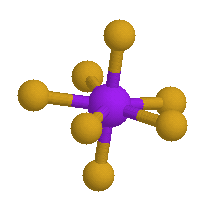The inter-halogen compound IF7 is pentagonal bipyramidal and should exhibit d3sp3 hybridization. What orbitals on the Iodine do you "mix" to form its seven hybrid orbitals? Are the 4f AO's at all involved?
 For this, I went to F.A. Cotton's classic textbook Chemical Applications
of Group Theory. IF7 has D5h symmetry, and the
seven F atoms must be combined into seven symmetry-adapted linear
combinations (SALC) according to the rules of group theory, each with a
symmetry corresponding to an element of the D5h point group.
Each SALC will be able to interact with one or more atomic orbitals on the
central I atom, according to its symmetry.
For this, I went to F.A. Cotton's classic textbook Chemical Applications
of Group Theory. IF7 has D5h symmetry, and the
seven F atoms must be combined into seven symmetry-adapted linear
combinations (SALC) according to the rules of group theory, each with a
symmetry corresponding to an element of the D5h point group.
Each SALC will be able to interact with one or more atomic orbitals on the
central I atom, according to its symmetry.
This answer is not going to be unique! I am assuming sp3d3 hybridization, but one could equally well construct molecular orbitals using only the s and p AOs of iodine; or using one or more of the 4f orbitals. For which orbitals are important we need to go to computational results, and computational results indicate that neither d nor f AOs are involved in bonding in p-block compounds to any appreciable extent. For references, see this previous answer.
I want to point out that, because I'm only interested in which AOs on iodine are important, I am including only a single hybrid AO from each fluorine atom in my model, . This is a drastic oversimplification if we are actually trying to construct molecular orbitals!The irreducible representation in the D5h point group, of the seven fluorine atoms of IF7, is
2A1' + A2" + E1' + E2'
According to the orbital tables Cotton provides, the iodine AOs which correspond to these four types of symmetry are:
| A1' | s, dz2 |
| A2" | pz |
| E1' | px, py |
| E2' | dx2-y2, dxy |
Therefore, any hybrid-orbital model of IF7 using sp3d3 hybridization will necessarily involve only dx2-y2, dxy and dz2 from the five d AOs.
According to the table, we could construct a perfectly good MO model using only the iodine s, px, py and pz AOs. In such a model, the two E2' MOs, and one of the A1' MOs, would be non-bonding, and would be a means of modeling the excess negative charge on the seven fluorine atoms. As noted above, this model might be considered more "real" because computational results indicate that d AOs do not participate in bonding in the p-block elements--and more importantly, because experimental results strongly indicate that there is considerable excess negative charge on the fluorine atoms.For representations of the various hydrogen-like atomic orbitals, see Yue-Ling Wong's VRML site.I don't know the symmetries of the 4f AOs in any point group, so I can't say which 4f AOs could be included in a hybrid-orbital model of IF7.
| Dan Berger |
| Bluffton College |
| http://www.bluffton.edu/~bergerd |